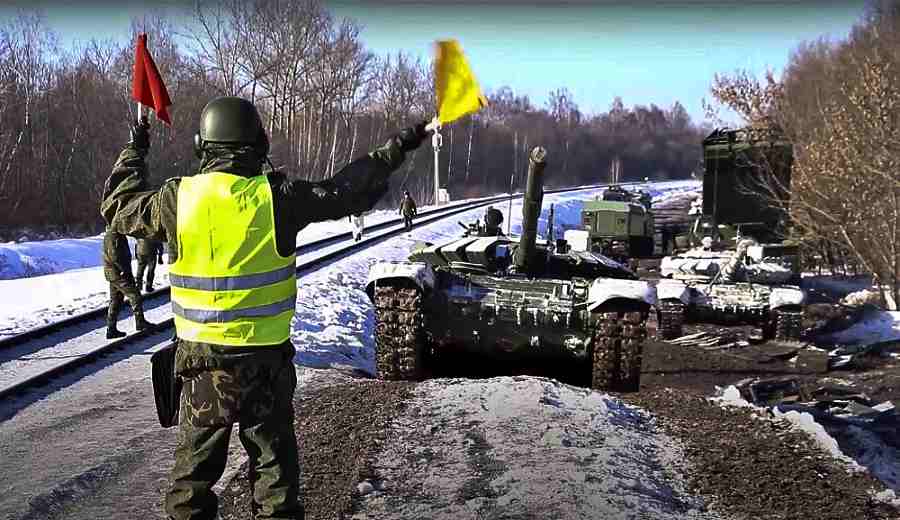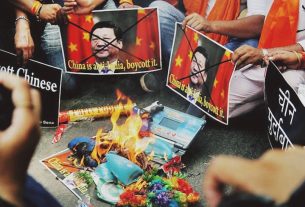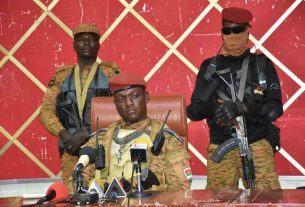Sat 19 February 2022:
Moscow, Russia – On February 1, Igor, a middle-aged truck driver from Krasnodar posted a video on TikTok of a Russian military convoy cruising down a two-lane road in a rural area.
The short clip has gathered a little over 350 views – but it was quickly picked up by hawk-eyed analysts who monitor Russia’s military using open-source information and usually post their findings on Twitter.
Ruslan Leviev, founding member of Conflict Intelligence Team (CIT), an independent Russian investigative organisation, is among them. He says TikTok videos showing the Russian military on the move are increasingly taking up a significant amount of researchers’ time – especially now, as tensions ratchet up on Russia’s border with Ukraine – helping them to report and analyse movements across the country.
Here’s what we know of Russian deployments around Ukraine as of the evening of February 13. The preparations for a possible large-scale operation are nearing completion https://t.co/xm4Jk5JS4v pic.twitter.com/5QrJmvHSNR
— CIT (en) (@CITeam_en) February 14, 2022
Leviev says the people behind the posting of such content are usually truckers, railway workers and residents. In fact, Igor’s TikTok was just one video in a stream of content depicting Russian military movements, including by the national guard, an internal military force that as Leviev suggests can be deployed to perform military police functions on Russian-controlled territories.
“The national guard performed similar functions in Syria. It can also be used to prevent information leaks as it can be posted at the entrances to the field camps and block journalists, eyewitnesses and onlookers with cameras,” Leviev told Al Jazeera.
TikTok diplomacy
In recent months, observers using open-source intelligence techniques to research Russia’s military presence watched on as Russia moved forces from all over the country to annexed Crimea, near the Ukrainian border and the neighbouring country of Belarus.
“Pay attention to how military equipment moved,” Valery Shiryaev, a military columnist for Novaya Gazeta, told Al Jazeera. “They were moving at minimum speed from the Far East. They did everything so everyone could see them,” he added, noting that Russia’s military transfers have upped the ante during the negotiations over the Russia-Ukraine crisis.
Shiryaev also argues that the deployments from the Far East at the end of January did not include foot soldiers, saying this was noticeable from satellite images and videos posted on social networks.
Such a large military presence is not unprecedented, Shiryaev says, pointing to Ukrainian newspapers reporting the presence of as many as 100,000 Russian soldiers in bordering regions several years ago. He says that this number is constant because of a continuous cycle of military exercises taking place in these regions that have seen military personnel come and go with each new drill.
“Now these exercises are being used as part of a system of military-political pressure. No one knows whether the results will be achieved, but [Russian President Vladimir] Putin has already forced Western countries to sit down at the negotiating table,” says Shiryaev. “This is already a victory.”
Open secret
Still, observers say the Russian state is generally keen to avoid disclosing information about military movements, with the country’s secret services actively protecting such details.
CIT’s Leviev and his colleagues use public data about train movements in their investigations, but in December railway data concerning military transportation was removed from public records. However, Russian special services failed to completely hide this information from researchers, according to Leviev, who still uses Russia’s open train data for his work.
Russian soldiers, meanwhile, are banned by law to use mobile phones and other internet-connected devices while on service or on base, as well as post information related to their work.
But it leaks, nonetheless.
“The practice of criminal law in Russia is completely unpredictable,” Stanislav Seleznev, lawyer from the Network Freedoms project, told Al Jazeera when asked if TikTok videos showing military vehicles will have legal implications for those posting them.
Seleznev referred to criminal cases launched against five women for charges of treason and espionage for sending SMS messages about the movements of military equipment to their friends from Georgia during the 2008 Russo-Georgian war. The women were originally sentenced to between six and 12 years in prison, but were all released by late 2017 following a public outcry.
According to Seleznev, when Russia’s main security service FSB decides to initiate criminal prosecution, it will consider how often such information appears on a suspect’s social media and whether they are informing the audience about what kind of equipment is depicted, as well as where and why it is going. Prosecution may be initiated despite the fact that it is impossible for citizens to predict what events will be part of a covert operation, Seleznev adds.
“Last year, the risks increased sharply, as the FSB approved a list of information that is not a state secret, but can be used by foreign organisations against the security and national interests of our country. We are completely covered by this list,” said Leviev.
Because of this list, CIT’s publications could now lead to criminal penalties. The group has five members, three of whom live in Russia – out of these three, only Leviev is public about his participation with CIT. Despite this, Leviev says that for now, he is not planning to leave the country.
On February 15, Russia’s defenсe ministry said that it started pooling some of its troops from exercises in bordering regions and posted a video to support its claim. According to CIT, the Russian military still can be seen moving towards border regions, including columns that were already on their way on Tuesday and newly sent ones. And on Friday, a US official said the Russian build-up numbered up to 190,000 personnel, calling it the “most significant military mobilisation in Europe” since World War II.
_____________________________________________________________________________________________________________
FOLLOW INDEPENDENT PRESS:
TWITTER (CLICK HERE)
https://twitter.com/IpIndependent
FACEBOOK (CLICK HERE)
https://web.facebook.com/ipindependent
Think your friends would be interested? Share this story!





